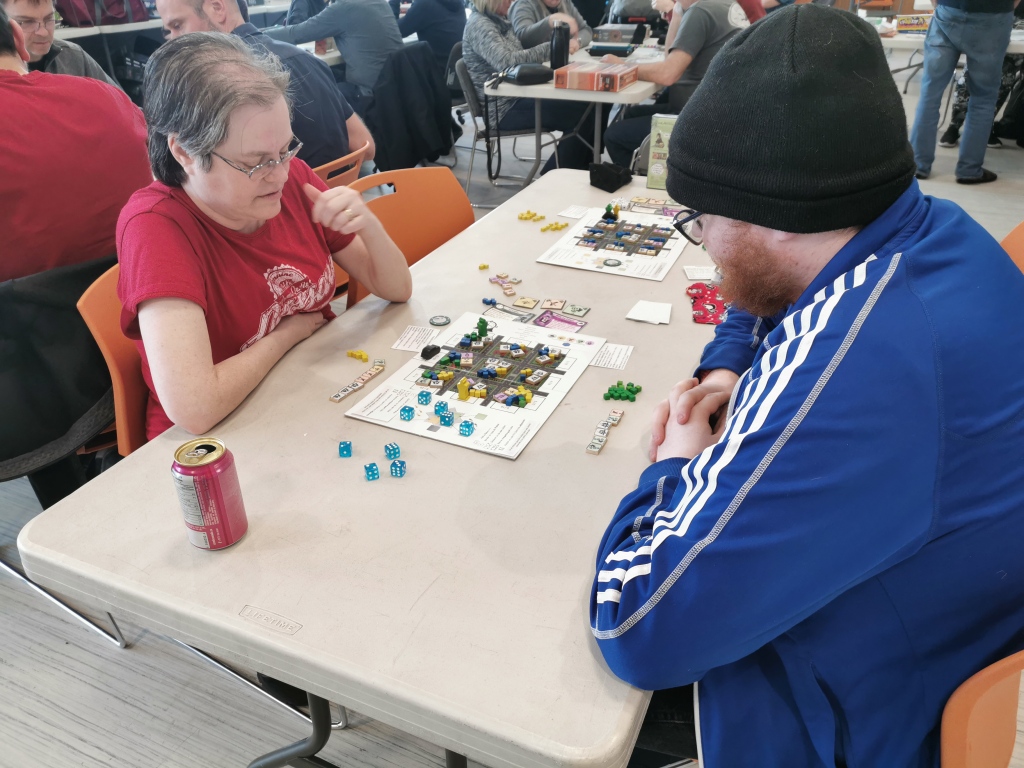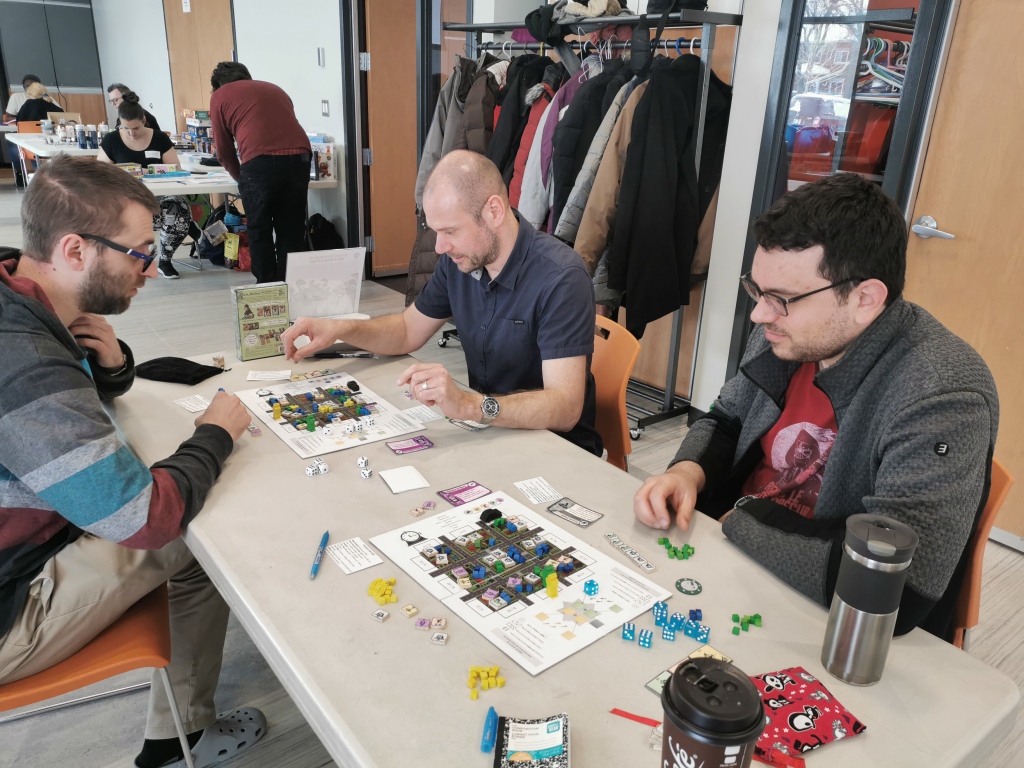Last weekend, I went to a local gaming event to playtest With A Smile & A Gun, and hopefully get a few mailing list subscribers. This article is meant to give a few tips and tricks to those of you who are looking to do something like this. I’m far from an expert on approaching potential testers, and maybe you disagree with some of these: let me know in the comments in that case.
Before I go into the tips, a quick presentation of the event: I went to the Bissextile Ludique (Bissextile is French for leap year, because it was February 29th, and Ludique means fun), organized by Longueuil Ludo, which organizes weekly game nights at a community center, and bigger events a few times a year. There were about 70 people, there were two merchant booths, a flea market, raffles and tournaments, and a Prototype zone for 3 designers—actually, it was just three adjacent tables in the main gaming area. That last part is important: it means that we had more traffic than if we were in a separate room, but it also means that we often had to explain why we were showing off this crappy game that looks like it was printed on our home HP (hint: it was!). In an event this small, a separate room would most likely have meant no traffic.
I’ll also assume your game is ready to be playtested with strangers. Don’t take your first drafts to strangers: you’ll burn their goodwill, it’s harder to get them to try it, and a buddy’s feedback would have been just as helpful. By the time you go to those events, your game’s core should work, and you want to have new perspectives on it. Your game should also look presentable: it doesn’t have to be full of art, but the graphic design should be clear and understandable. It should not look like homework, and you should have an intriguing pitch to hook them in.
Tip 1: Be approachable.
Please smile. Please don’t look like people are disturbing you. Please talk to those around you. Testing or demoing for someone is a lot easier if you know them, even a little bit.

In an event this small, there were times where I was without any testers, and everyone was sitting down in a game. Then, I’d get out my phone, or go for a quick browse of the flea market. But if there were people moving around, get up and invite people over. Even if they’re fascinated by your prototype, most people won’t disturb you if you look busy.
Tip 2: Build social capital.
Even if you’re approachable, that’s still not enough. At an event like this, people will have a choice between a game they actually know and love, learning a new game they’ve been yearning to get to the table, or this prototype you brought. Some people love helping out, love trying games in development and having some input on final products, but for most people, that’s not the case. Whether they’ve never tested a prototype before, or been burned too many times, or just don’t enjoy it, you’re often fighting an uphill battle.
The best way to turn it on its head is to make a connection with people, so that when you ask them for a playtest, they want to help you. If you have down time, play a game with them. Walk around and look at other people’s games: I spent a good 20 minutes observing a game of Marvel Champions last Saturday, which was both awesome, because that game rules, but also allowed me to connect with those players. I participated in a Just One tournament (well, actually, won a Just One tournament, thank you very much) with another 6 people. Later on, when all those folks came back from dinner, I could call them by their name and invite them over to play.
Of course, respecting people’s boundaries, adapting your approach to their particularities, reading the room, and other social guidelines very much apply here.
Tip 3: Be respectful of their time.
Once you get a tester to sit down and play your game, you’re not done: word of mouth is still a thing. If a tester gets up from your table and tells others your game was a waste of time, you might as well pack up for the rest of the day. On the other hand, if someone gets up and tells their buddies to come and try it out, they’re doing your job for you—and are probably much more efficient than you are.
This is not about delivering a good game experience, but it’s being respectful and grateful for their time. Set the game up before players sit down. Have your explanation prepared and rehearsed. Listen to their feedback. But also, if a tester wants to drop out before the game’s end, that’s fine: just sit in for them. If multiples do, don’t pressure them to stay. Actually, after the first round, you should ask everyone if they want to go through the rest of the game. That’s the difference between answering “it wasn’t for me” when asked, and actively telling everyone around them “I just wasted half an hour of my life”. You won’t get good feedback from frustrated people anyway.

Also related is “Know the crowd”: look up the event. When I saw on the Facebook group the kind of games people were playing on pictures, I went with my 20-30 minute dice game, not my 90-min engine building, area control Euro game.
Tip 4: Raffles are… meh?
So I thought about the “Give before you ask” mantra, and decided I’d raffle a game amongst those who tested my prototype and left me their email for the mailing list. I thought about raffling a pledge for the game, but decided maybe a prize that you’d get a year after you won it wouldn’t be that enticing. I therefore bought a copy of Jixia Academy, the newest edition of Hanamikoji, which is another 2-player majority game, thinking if they’d like one they’d like the other. Price wise, the FLGS copy of Jixia was about the same as the landed cost + shipping of my game. Tomato-tomato (wow does that not translate well to written text), I don’t feel strongly either way. If I were closer to the KS, I’d probably go for a pledge. Maybe they’ll be interested in adding more copies, since I’d already cover shipping?
I had the box on my table, next to my display of the game’s cover image and basic instruction. People were confused, so I added a sticker on it that said “Try my prototype for a chance to win this DIFFERENT, yet AWESOME game”. Which made people a bit less confused, but still… pretty confused. The pledge would probably have been a better option on that end.
And even if that were clear, of the 19 emails I got, 19 said they would have given me their emails even if it weren’t for the raffle. And no one was attracted to the table because of the raffle. At the end, I still drew the name and gave them the prize, and they couldn’t. care. less.
I’m still happy I did it, but I probably wouldn’t do a raffle again. I might organize a play-to-win tournament, where the winner gets a copy of the game, and maybe others get a coupon. However, I’d only do so with physical copies of the game after fulfillment, or by offering a pledge during the Kickstarter (or possibly, in the weeks right before it).
Where I’d do a raffle is for a Gleam campaign, “subscribe to my social media for a chance to win”, where that chance at a prize is the only thing you’re offering. In this case, I think at best it didn’t matter, and at worst is might have even taken away from the genuine “I want to go when this comes out” value of giving your email address.
So that’s that. Have you ever gone to such an event to playtest or demo your game? How did you get people to your table?